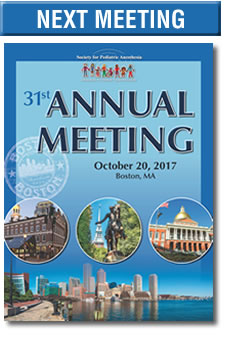sppm review
Review of the Fourth Annual Meeting for the Society for Pediatric Pain Medicine (SPPM)
By Franklin Chiao, MD and Anjana Kundu, MBBS, MD, ABIHM
The fourth Annual Meeting for the Society for Pediatric Pain Medicine, held in Austin Texas, showcased an exceptional educational program. The day opened with a welcome note from Sabine Kost-Byerly, MD (Johns Hopkins University), the president of SPPM and Stephen Hays, MD (Vanderbilt University) who chaired the Annual Meeting program.
The focus of the first session was “science of pain” and opened with a great review of neuroimaging in pediatric pain disorders by Alyssa A. Lebel, MD (Boston Children’s), a pediatric neurologist and pain physician. She analyzed functional MRI, diffusion tensor imaging, NIRS, MR spectroscopy, resting state networks, arterial spin labeling, and magnetoencehalography. This was followed by a presentation by Terri Voepel-Lewis, RN MSN (CS Mott Children’s) focused on assessment of pain in cognitively impaired children where self-report of pain is unlikely or subject to biases due to the varying degree of cognitive developments. She discussed the objective pain scales used in this population and pitfalls or biases that may pose challenges to appropriate assessment and management of pain amongst this population.
Another fascinating and emerging pain assessment using facial expressions especially for neonatal population has gained some attention in the recent years. Dr. Carrie Menser, MD (Vanderbilt University) discussed her research exploring the relationship between crying acoustics and pain amongst neonates. This is a promising area, but does pose the challenges of identification of cry acoustics based on nociceptive pain from those occurring due to there distressing events such as hunger, or other physical non-painful stressors. Further investigation in this area work needs to be done on an algorithmic approach.
The second session of the day focused on acute pain and regional analgesia, with emphasis on new directions for old techniques, featuring both new and well-established speakers. Dr. Benjamin Record, MD (Memorial Sloan-Kettering Cancer Center) opened the session discussing the literature supporting merits of intermittent mandatory bolus epidural analgesia and contrasting it with our current common practices of continuous and PCEA modes. Programmed intermittent epidural boluses compared with continuous infusion or PCEA resulted in less total local anesthetic dose requirement while providing comparable analgesia.
Next, Dr. Megan Brockel, MD (Children’s Hospital of Colorado) evaluated available evidence for enhanced recovery after surgery (ERAS) protocols in adults and children. The available literature on ERAS demonstrates that a systematic, multidisciplinary approach to perioperative management of patients reduces complications, length of stay and readmission rates. It also highlights the pivotal role of appropriate analgesia in the ERAS pathways.
The third presentation of this session included Charles B. Berde, MD, PhD (Boston Children’s) sharing available research on options for longer acting local anesthetics including his own extensive research on Neosaxotoxin. While, the current local anesthetics in use provide relatively limited (hours) duration of analgesia and relatively lower potency, Neosaxitoxin may provide prolonged analgesia lasting up to two to three days. These morning sessions provide a glimpse into the exciting innovations and research occurring in the field of pediatric pain management, enhancing our ability to provide better care for our children as a specialty.
Lunch featured an excellent collection of Problem Based Learning Discussions spanning across acute, chronic, cancer pain, regional analgesia and palliative care topics. Post-lunch session featured presentations related to chronic pain, complementary and alternative medicine and palliative care topics.
Tracy Jackson, MD (Vanderbilt University) discussed the current factors contributing to the opioid epidemic, and how we can actively work to combat the crisis. She also highlighted the roles played by appropriate evaluation, patient education about chronic pain and use of multidisciplinary approaches beyond pharmaceutical agents in treatment of chronic pain. The presentation by music therapist Shea Ingram (Cook Children’s) was a treat not only for our intellect with the evidence discussed, but also a fantastic experiential exercise when she lead the audience through demonstration of how music can engage people in more positive mindset and enhance production of “feel good” neurotransmitters. Thus, music has a very positive impact on pain management and creating social connections, a major factor in those suffering from pain. Meredith Brooks, MD (Cook Children’s) discussed the range of interventional techniques available for chronic pain in children. Though these techniques are much less commonly employed in pediatrics, available literature supports their use in appropriate conditions.
The fourth and final session of the day, led by Sapna Kudchadkar, MD (Johns Hopkins), featured award-winning poster presentations for Regional Analgesia, Acute, Chronic and Palliative pain. The final podium presentations of the day were dedicated to the review of medical literature relevant to pediatric pain medicine. Vidya Chidambaran, MD (Cincinnati Children’s) presented the basic science research articles, Lisqelia Santana-Rojas, MD (Nemours Children’s) presented the top publications about acute pain and regional analgesia and finally, Dr. Neil Raj Singhal, MD (Phoenix Children’s) presented the latest literature on chronic pain and palliative care.
Upon conclusion of the podium presentations, attendees could quench their academic and intellectual thirst attending an excellent collection of moderated poster sessions and a variety of workshops including creating the ideal pediatric pain management service, ultrasound-guided pediatric chronic pain management, joint workshops with SPA on acupuncture and advanced ultrasound-guided regional anesthesia.
Overall, this day was packed with great content for everyone engaged in the practice of pediatric pain and regional anesthesia!
For those interested in a more detailed account of this meeting, a complete review will be included in the summer SPPM newsletter.






